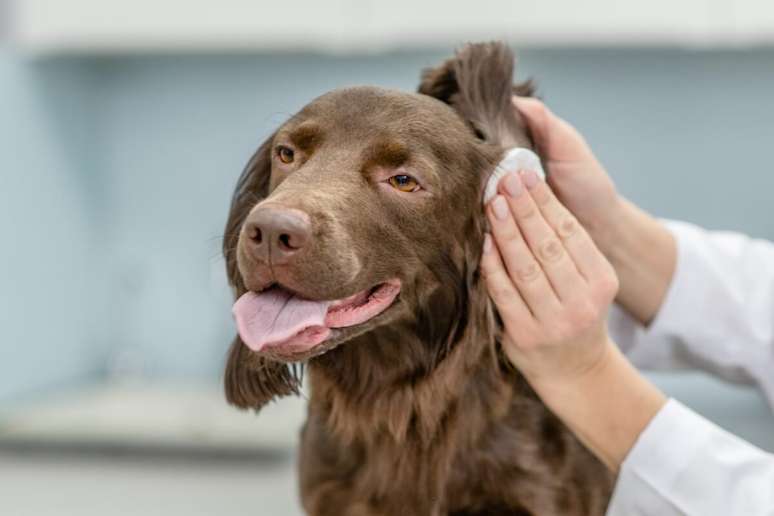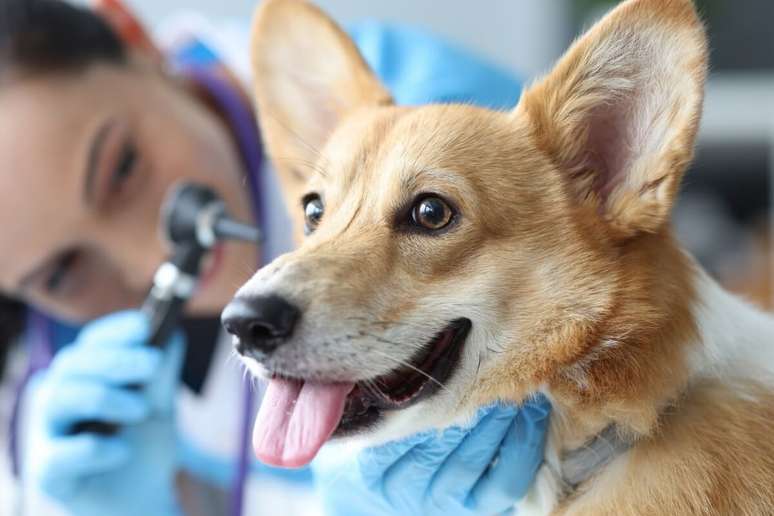The vet explains the causes of this type of inflammation that affects dogs’ ears
Etitis, a common disease in dogs, is a common complaint in veterinary offices. It is a common condition that affects dogs’ ears and can cause discomfort and irritation. It is characterized by inflammation of the ear canal and can be caused by several factors.
«The underlying cause is almost always inflammation. This inflammation can be triggered by various factors such as trauma, parasites, foreign bodies and neoformations such as polyps, but, in the vast majority of cases, the initial factor is the allergic disease. remember that the external auditory canal is covered with skin and, if the dog is allergic, this skin will also become inflamed”, explains Ricardo Cabral, veterinarian and technical director of Virbac do Brasil (pharmaceutical company dedicated to animal health).
Inflammation leads to changes in the ear’s microenvironment, such as changes in temperature and humidity, as well as increased earwax production. These, in turn, in some cases, secondarily lead to bacterial and/or fungal infections.
Differences between otitis externa, media and interna
According to Ricardo Cabral, otitis can be classified into three main types based on the location of the infection. The vet provides more details:
1. Otitis externa
It refers to the most common form of ear infection in dogs and occurs when the external ear canal becomes inflamed. “Inflammation can be caused by several factors, such as hair removal/cleaning incorrect form that generates trauma or even parasites and foreign bodies, but generally the cause is allergic”, explains the professional.
According to the specialist, about 75% of cases of otitis externa have in common the fact that they affect allergic animals. Because it is a difficult disease to control, recurrent otitis externa is quite common.
2. Otitis media
According to the vet, this type of ear infection affects the middle part of the ear, located behind the eardrum. “It can occur as a complication of otitis externa when the infection extends into the ear,” he says.
3. Internal otitis
This is the least common form of ear infection in dogs. “It is generally more serious, because it involves inflammation of the inner part of the ear, including the cochlea and the labyrinth, which are essential for hearing and balance. This type of ear infection can be associated with bacterial, fungal, viral infections or even immunological problems, head trauma or tumors”, explains Ricardo Cabral.
Symptoms of ear infection in dogs
The veterinarian warns of the need to pay attention to the dog’s behavior to observe any behavior that may indicate the problem. “Excessive itching in the earrubbing your head on the floor or furniture, redness or inflammation in the ear, discharge or bad odor, shaking or tilting your head more frequently, sensitivity to touch, hearing loss and increased sensitivity are some of the signs of ear infection,” he says The specialist.
Breeds predisposed to ear infection
Some dog breeds are more predisposed to developing ear infection due to specific anatomical characteristics of their ears or genetic conditions that increase earwax production. Among these, Ricardo Cabral highlights:
- Cocker spaniels;
- Labrador, especially chocolate-colored;
- Beagles;
- dachshund hound;
- Golden retrievers;
- Poodle.
However, it is worth remembering that any breed of dog can develop this condition.

Treatment for ear infection in dogs
Treatment for ear infection in dogs varies depending on the cause, condition, and severity of the infection. “The first step is to bring the pet to the vet’s office for a complete examination, and in the case of otitis externa, cleaning and topical treatment are sufficient to treat the problem,” advises Ricardo. According to the doctor-veterinarianonly in the most serious or persistent cases may it be necessary to prescribe oral drugs, such as antibiotics or anti-inflammatories.
Risks of excessive antibiotics in the treatment of otitis
To date, veterinarians only use combinations of anti-inflammatories, antibiotics and antifungals to locally treat canine otitis externa, while simultaneously combating the underlying inflammation and secondary infections.
“The problem is that we are increasingly seeing the appearance of antimicrobial-resistant microorganisms, which means that the bacteria present in the dog’s ear can become resistant to the antibiotic used, making the treatment ineffective. Considering that the cause of the disease is inflammation, do we always have to use antibiotics?”, comments Ricardo Cabral.
The specialist also warns that since most cases of otitis externa are triggered by illness For allergies that have no cure, it is common for dogs to have recurring ear infections. In this scenario, the frequent use of antibiotics and antifungals in these conditions contributes to the indiscriminate use of this class of drugs.
Corticosteroids are an alternative to antibiotics
As the veterinarian explains, the possibility of using corticosteroids as a first choice is a way to prevent the increasingly common appearance of animals with high resistance to antibiotics. “This type of treatment acts on the primary cause of non-purulent otitis, on an allergic basis. In treating the inflammation, the bacterial and fungal microbiome must be controlled in a natural way, returning to its original state”, he explains.
According to him, in this case, the veterinarian recommends treatment with corticosteroids for 7 to 14 consecutive days, depending on the clinical response of the animal. “If healing is not confirmed after the first seven days of treatment, it will need to be extended up to 14 days, according to the veterinary assessment,” advises the professional.
In addition to the type of medicine, Ricardo Cabral recommends paying attention to the applicator of the medicine. “As this is a topical treatment, you need to take a little during application, for example by opting for applicators spraysoft and silent, which do not irritate or frighten dogs, as well as an anatomical cannula, to make the treatment as comfortable and safe as possible for the animal”, concludes the specialist.
By Catarina Armelin
Source: Terra
Ben Stock is a lifestyle journalist and author at Gossipify. He writes about topics such as health, wellness, travel, food and home decor. He provides practical advice and inspiration to improve well-being, keeps readers up to date with latest lifestyle news and trends, known for his engaging writing style, in-depth analysis and unique perspectives.









